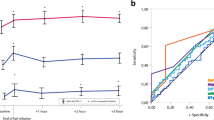Summary
Intravascular volume expansion has been shown to improve cardiac output in experimental cardiac tamponade. To determine the limitations of intravascular volume manipulation, acute tamponade was created in 20 anesthetized, spontaneously breathing dogs. The intrapericardial volume causing tamponade was determined for each animal, and kept constant. Hemodynamics were recorded with and without tamponade at multiple levels of intravascular volume. During cardiac tamponade, intravascular volume expansion increased cardiac output only in animals which were initially volume-depleted. Volume expansion of normovolemic or hypervolemic animals caused minimal changes in cardiac output, but increased atrial and aortic pressures. Intravascular volume depletion of the normovolemic animal caused a significant decline in cardiac output, in contrast to the trend towards an increased output following phlebotomy of the volume-expanded animals. In general, the benefit of intravascular volume expansion during cardiac tamponade could only be demonstrated when atrial pressures were below 12 mm Hg.
Similar content being viewed by others
References
Antman EM, Cargill V, Grossman W (1979) Low-pressure cardiac tamponade. Ann Int Med 91:403–406
Beck CS (1942) Further observations on stab wounds of the heart. Ann Surg 115:698–704
Bigger IA (1939) Heart wounds: Report of 17 patients operated upon in Medical College of Virginia hospitals and discussion of treatment and prognosis. J Thorac Surg 8:239–253
Boettcher DH, Vatner SF, Heyndrickx GR, Braunwald E (1978) Extent of utilizations of the Frank-Starling mechanism in conscious dogs. Am J Physiol 234:H338-H345
Cohen MV, Greenberg M, Grose R, Yipintsoi T (1984) Cardiac tamponade in dogs with normal coronary arteries. II. Myocardial flow and metabolism with moderate and severe hemodynamic impairment. Basic Res Cardiol 79:542–550
Cooper FW, Stead EA, Warren JV (1944) The beneficial effect of intravenous infusions in acute pericardial tamponade. Ann Surg 120:822–825
Craig RJ, Whalen RE, Behar VS, McIntosh HD (1968) Pressure and volume changes the left ventricle in acute pericardial tamponade. Am J Cardiol 22:65–74
Crystal GJ, Bashour FA, Downey HF, Parker PE (1979) Myocardial blood flow and oxygen consumption during moderate cardiac tamponade: role of reflex vasoconstriction. Proc Soc Exp Biol Med 160:65–68
DeCristofaro D, Liu CK (1969) The haemodynamics of cardiac tamponade and blood volume overload in dogs. Cardiovasc Res 3:292–298
Ferguson R, Bristow D, Mintz F, Rapaport E (1963) The effects of pericardial tamponade on left ventricular volumes and function as calculated from aortic thermodilution curves (abstr). Clin Res 11:100
Fowler NO (1974) Pericardial disease. In: Hurst JW (ed) The heart, arteries and veins (3rd edition). McGraw-Hill Book Co, New York, p 1399
Fowler NO, Gabel M, Holmes JC (1978) Hemodynamic effects of nitroprusside and hydralazine in experimental cardiac tamponade. Circulation 57:563–567
Gascho JA, Martins JB, Marcus ML, Kerber RE (1981) Effects of volume expansion and vasodilators in acute pericardial tamponade. Am J Physiol 240:H49-H53
Grose R, Greenberg M, Steingart R, Cohen MV (1982) Left ventricular volume and function during relief of cardiac tamponade in man. Circulation 66:149–155
Guberman BA, Fowler NO, Engel PJ, Gueron M, Allen JM (1981) Cardiac tamponade in medical patients. Circulation 64:633–640
Isaacs JP, Berglund E, Sarnoff SJ (1954) Ventricular function. III. The pathologic physiology of acute cardiac tamponade studied by means of ventricular function curves. Am Heart J 48:66–76
Jarmakani JMM, McHale PA, Greenfield JC, Jr (1975) The effect of cardiac tamponade on coronary haemodynamics in the awake dog. Cardiovasc Res 9:112–117
Kerber RE, Gascho JA, Litchfield R, Wolfson P, Ott D, Pandian NG (1982) Hemodynamic effects of volume expansion and nitroprusside compared with pericardiocentesis in patients with acute cardiac tamponade. N Eng J Med 307:929–931
O'Rourke RA, Fischer DP, Escobar EE, Bishop VS, Rapaport E (1967) Effect of acute pericardial tamponade on coronary blood flow. Am J Physiol 212:549–552
Parker JO, Case RB (1979) Normal left ventricular function. Circulation 60:4–12
Reddy PS, Curtiss EI, O'Toole JD, Shaver JA (1978) Cardiac tamponade: hemodynamic observations in man. Circulation 58:265–272
Rushmer RF (1954) Shrinkage of the heart in anesthetized, thoracotomized dogs. Circ Res 2:22–27
Rushmer RF, Smith O, Franklin D (1959) Mechanisms of cardiac control in exercise. Circ Res 7:602–627
Shabetai R, Fowler NO, Guntheroth WG (1970) The hemodynamics of cardiac tamponade and constrictive pericarditis. Am J Cardiol 26:480–489
Spodick DH (1967) Acute cardiac tamponade: pathologic physiology, diagnosis and management. Prog Cardiovasc Dis 10:64–96
Treister B, Gianelly RE, Cohn KE, Harrison DC (1969) The circulatory effects of isoproterenol, acetyl-strophanthidin, and volume loading in acute pericardial tamponade. Cardiovasc Res 3:299–305
Zar JH (1974) Biostatistical analysis. Prentice-Hall, Inc, Englewood Cliffs, NJ
Author information
Authors and Affiliations
Additional information
Dr. Cohen is the recipient of a Research Career Development award from the National Heart, Lung and Blood Institute, HL-00281.
Rights and permissions
About this article
Cite this article
Grose, R., Greenberg, M.A., Yipintsoi, T. et al. Cardiac tamponade in dogs with normal coronary arteries. I. Effect of changing intravascular volume on hemodynamics and myocardial blood flow. Basic Res Cardiol 79, 531–541 (1984). https://doi.org/10.1007/BF01910482
Received:
Issue Date:
DOI: https://doi.org/10.1007/BF01910482




